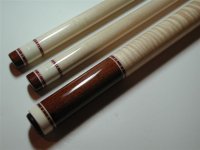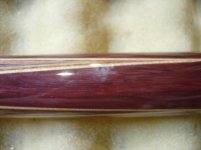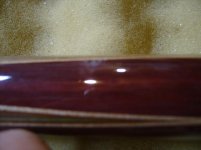UV vs. Automotive Clear
I was using two different clear before.
Defleet F3930 which is used to paint semi trucks. It's like an armor coating for wood but takes 2 months to dry. Expensive
and Deltron DC3000
After spraying a few test pieces and a couple cues UV has lots of advantages.
First and most important is shrinkage. Regular auto clears have about 65% loss from shrinkage and evaporation. The UV clear has less then 5% loss from evaporation and shrinkage.
I was waiting 3 weeks to polish a cue. Now I wait 1 hour.
And it's durable. It's better for the environment. It's better for my health.
Hi,
For what it's worth, I went down the UV road 4 years a go and I am back to Concept and Omni automotive clear coats for my cues for the following reasons.
1). All of my attempts to buff the UV came out "ok" but I could not get the look I wanted with it. After all of my wet sanding, I buff with a three step system. When this is complete I use a big buffer with a 12" donet flanel wheel @ 1725 rpm polishing vertically. With by procedures, the shine & luster from automotive clear is so deep and wet looking that I would not wish to go in another direction. I have seen some good UV finishes, but non that compares.
I used the Van Technologies products and one another that name escapes me at this time.
Maybe you have a new product that you could share. I have not closed my mind to UV but I need some motivation to go down that road again.
2). The hardness of the UV product is a great asset but I have noticed that on many exotics after an impact to the cue a finger nail looking pocket is sometimes revealed under the finish. I don't get this with automotive clear. After a pin point impact you will get a dent but it will not be visually amplified by the finger nail spot under the finish that is noticeable from across the room.
3.) With the products I use I can sand and buff after 24 hours depending on the temperature. I always wait 48 hours. Waiting 48 hours to wet sand and buff is not a problem for me. 3 weeks would not be acceptable to my business.
4.) As far as the health issues are concerned, you must always wear a mask when mixing or spraying any product, UV notwithstanding. The UV rays at the spectrum and intensity used in this process must not be taken lightly either. When using these lights you must were a welders shield ( just squinting your eyes is not enough) and make sure no eyes or skin is expose to even a little reflective light.
No matter what you do cues are going to get banged up and need refinishing if they have value. To fix the finger nail thing you have to go all the way down to the wood to repair. With dents, it is much easier to do the refinish job using a variety of techniques before re spraying.
As far as the shrinkage is concerned in the automotive finish I think I have got around that feature. I have found that if you use 4 coats of G5 epoxy reapplied every 4 minutes you will get monolithic chemical structure. Uniformly flat sanding the epoxy substrate with full sheets of sand paper to a level elevation grade will leave no thin spots or burn through and the clear will not shrink at the rings. The trick is to have enough thickness in the epoxy to sand out the high spots and still having enough material to give you a solid base coat. The epoxy sealer is the structure and the paint is the coating. I have cues out there that are not shrinking after 15 months when I started the 4 coats of epoxy coating step. For the record, I do not use metal rings, only wood and rod & tube materials ie. phenolic , ivory, Juma ect.
Rick Geschrey



